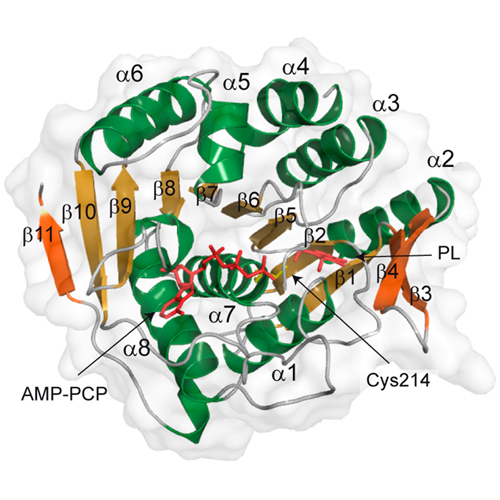A Subfamily of Bacterial Ribokinases Utilizes a Hemithioacetal for Pyridoxal Phosphate Salvage
06-Mar-2014
J. Am. Chem. Soc., 2014, DOI: 10.1021/ja411785r, 136 (13), pp 4992–4999 published on 06.03.2014
Pyridoxal 5′-phosphate (PLP) is the active vitamer of vitamin B6 and acts as an essential cofactor in many aspects of amino acid and sugar metabolism. The virulence and survival of pathogenic bacteria such as Mycobacterium tuberculosis depend on PLP, and deficiencies in humans have also been associated with neurological disorders and inflammation. While PLP can be synthesized by a de novo pathway in bacteria and plants, most higher organisms rely on a salvage pathway that phosphorylates either pyridoxal (PL) or its related vitamers, pyridoxine (PN) and pyridoxamine (PM). PL kinases (PLKs) are essential for this phosphorylation step and are thus of major importance for cellular viability. We recently identified a pyridoxal kinase (SaPLK) as a target of the natural product antibiotic rugulactone (Ru) in Staphylococcus aureus. Surprisingly, Ru selectively modified SaPLK not at the active site cysteine, but on a remote cysteine residue. Based on structural and biochemical studies, we now provide insight into an unprecedented dual Cys charge relay network that is mandatory for PL phosphorylation. The key component is the reactive Cys 110 residue in the lid region that forms a hemithioactetal intermediate with the 4′-aldehyde of PL. This hemithioacetal, in concert with the catalytic Cys 214, increases the nucleophilicity of the PL 5′-OH group for the inline displacement reaction with the γ-phosphate of ATP. A closer inspection of related enzymes reveals that Cys 110 is conserved and thus serves as a characteristic mechanistic feature for a dual-function ribokinase subfamily herein termed CC-PLKs.











